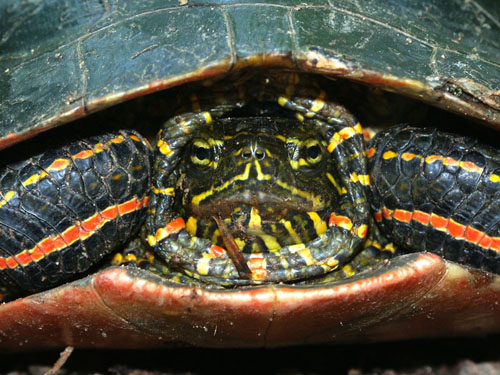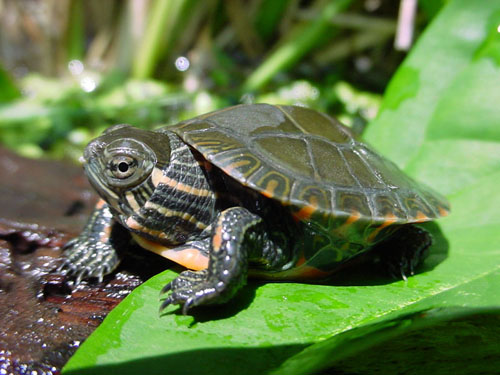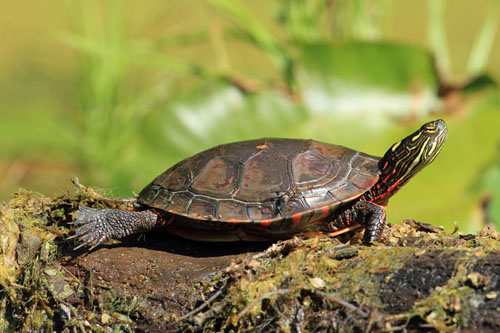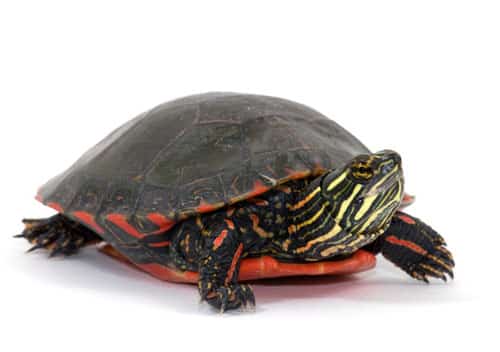Care sheet for the painted turtles (Chrysemys picta ssp. and C. dorsalis)
Painted Turtle (Chrysemys picta ssp. and C. dorsalis)
Well deserving of their common name, painted turtles are one of the most attractive varieties of pond turtle native to North America. Their range extends from the Pacific coast to the Atlantic coast and from Canada to northern Mexico, making them one of the most widespread species, as well. Inhabiting practically any slow-moving or still body of freshwater within their range makes painted turtles one of the most commonly encountered turtles, and their vivid coloration makes them one of the most recognizable.
There are four types of painted turtles: the eastern painted turtle (Chrysemys picta picta), the midland painted turtle (C. p. marginata), the western painted turtle (C. p. bellii) and the southern painted turtle (C. dorsalis). Although their native ranges vary (hence, their common names), their habits and captive care requirements are very similar.
Painted Turtle Availability
Painted turtles breed readily in captivity, and are frequently produced by hobbyists and turtle farms alike. As with most temperate species, their breeding season is restricted to spring and summer, so captive-bred babies are most commonly available from May through September. However, given the significant numbers of babies hatched yearly, they are typically available for most of the year and prices are very affordable.

Jason Patrick Ross/Shutterstock
There are reports of painted turtles living for up to 50 years in captivity!
Painted Turtle Size
Besides their attractive coloration, another appealing aspect of painted turtles is their manageable adult size. Large western painted turtles rarely exceed 8 inches in length, and southern painted turtles are not normally larger than 6 inches. Eastern and midland painted turtles are in between, maxing out at around 7 inches. Males do not usually get quite as big as females, but their size difference is not significant.
Painted Turtle Life Span
Painted turtles have been known to live as long as 50 years in captivity, so they can truly be (nearly) lifelong companions. Given proper diet, housing, and care, you can reasonably expect a painted turtle to live for 25 to 30 years.
Painted Turtle Housing
Housing for painted turtles can be as elaborate or as simple as you choose to make it, but there are some minimal housing requirements that must be addressed. While it would be difficult for most keepers to provide water that is too deep, the depth should never be less than about twice the width of the turtle’s shell. A basking area, upon which the painted turtle can leave the water completely, complete with a good basking light to help it thermoregulate, is an absolute must.
An underwater hiding place should be provided, as well, with care taken to ensure that the painted turtle cannot get trapped and drown. Non-toxic live or plastic plants can be provided for hiding and to forage among, although painted turtles will eventually shred any live plants whether they eat them or not. Although the painted turtle tank bottom can be left bare, substrate (sand, gravel, etc.) can be used for a more natural appearance, but choose a particle size that is either too large to be swallowed or so small that it will pass easily through your painted turtle’s digestive tract.

Paul Vander Schouw
Hatchling painted turtles such as this can be kept in an enclosure large enough to provide 10 gallons of water, along with a haul-out area where the turtle can completely dry off.
Because they are active and able swimmers, painted turtles should be provided with a tank as spacious as possible. At a minimum, a single baby or juvenile painted turtle should be provided about 10 gallons of water volume. This does not mean a 10-gallon tank, but at least a 15- or 20-gallon tank partially filled with 10 gallons of water. Increase the volume of water by 5 gallons for each additional baby turtle. As the turtle(s) reach adulthood and beyond they should be provided with a minimum of 20 gallons of water volume for the first turtle, with an additional 10 gallons of water volume for each additional turtle.
Painted turtles are adaptable and can be housed in virtually any suitably sized tank. Stock tanks, glass aquariums, plastic totes and garden ponds can all be appropriate housing for individuals or groups of painted turtles. They can be maintained indoors or out, and adequate protection from predators as well as escape prevention measures should be provided in either case.
Painted Turtle Lighting and Temperature
If there is a good dietary source of vitamin D to metabolize calcium, a UVA/UVB light may not be necessary, but many keepers choose to provide such lighting anyway. A good heat-emitting light should always be provided over the basking area, and either incandescent or fluorescent lighting can provide additional illumination if necessary. For turtles maintained outdoors, the sun will of course provide heat and UV rays and no further lighting is necessary.
Temperature gradients should be provided for the water, ambient air and basking area. Water should be maintained within the range of 75 to 80 degrees Fahrenheit; ambient air between 80 and 85 degrees, and the basking area should be kept between 85 and 95 degrees. Bear in mind that temperatures within an aquarium–especially if there is a hood or cover installed–will probably be different than the temperatures within the surrounding room, so it is important to periodically check the actual temperatures in the tank rather than relying on a general indoor thermometer/thermostat. Of course, keeping thermometers inside the painted turtle enclosure will help, too.

Brian Lasenby/Shutterstock
Wild painted turtles love to bask in the sun, and so do pet painted turtles. Be sure to provide a dock or something else that will allow your pet painted turtle to leave the water completely to dry off.
Painted Turtle Food
Painted turtles are omnivorous, and will accept both animal and plant matter with equal enthusiasm. Along with fish, worms and insects, offer them green, leafy vegetables and aquatic plants such as water lettuce, water hyacinth and duckweed. In addition to live and natural foods, there is a wide variety of commercial turtle food available on the market, and most have been formulated to provide optimum nutrition for turtles at all stages of growth. Pay attention to ingredient labels; I recommend diets with the following: 30- to 40-percent protein; low fat content; vitamin D and a high calcium-to-phosphorous ratio. I also recommend vitamin and mineral supplementation.
Painted Turtle Health
Provided with suitable housing and diet, painted turtles are active and energetic pets. But as with any animal, illness and disease can affect them. Some indicators of health problems include: swollen or sunken eyes; listing or inability to submerge; gaping or frothing at the mouth, or bubbles in the nose; excessive basking or refusal to enter the water; inability or refusal to feed; asymmetrical or irregular growth; obvious discoloration or open wounds on the skin or shell; or any other abnormal appearance or behavior. If your painted turtle exhibits any of these problems, veterinary attention is recommended. Be sure to use a vet that specializes in turtles and tortoises, or at least reptiles and exotic animals. A list of reptile vets can be found here.
Painted Turtle Temperament and Handling
Although not truly social animals, painted turtles are gregarious and capable of cohabitating with turtles of their own and other species with similar housing needs. Both sexes are capable of dominant or territorial aggression, but as long as adequate space and hiding areas are provided, this behavior is usually not severe enough to result in serious injury. Still, if consistent aggression is noted, it may be necessary to provide a larger habitat or even entirely isolate offending turtles.
Painted turtles are not domesticated animals that thrive on human affection and contact, so they should not be handled except as a matter of necessity. Despite appearances to the contrary, handling is stressful to the painted turtle and subjects the handler to biting and scratching by the turtle. Occasional handling to inspect a painted turtle for health or injuries, and occasionally relocating painted turtles to alternate containers during cleaning and maintenance of their primary habitat, is acceptable. As always, a thorough hand-washing with soap and warm water before and after a turtle or any related materials or equipment has been handled will help to avoid any disease transmission between human and turtle.
Paul Vander Schouw is an avid turtle hobbyist who maintains about 1,000 turtles representing more than 100 species and subspecies. He has successfully bred more than half of them.


